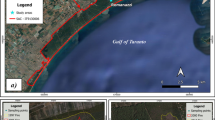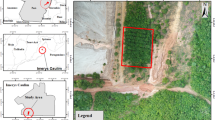Abstract
To clarify seedbank developmental pattern and its determinants, we examined relationships between seedbank, standing vegetation, and litter in a post-mined peatland on Sarobetsu Mire, northern Japan. In late fall 2006 and early summer 2007, peat was sampled from four vegetation types, and litter was also sampled from two of the four vegetations where thick litter was accumulated. Seed germination tests were performed by the samples in a glasshouse. The results were compared between the standing vegetation and litter accumulation. Seed density and species richness in seedbank gradually increased with increasing vegetation cover. Seeds in surface layer germinated more in fall than in summer. In vegetation with thick litter, small seeds, such as Drosera rotundifolia and Gentiana triflora, germinated more from peat than from litter in summer, probably due to the downward movement. Seed density in litter decreased from fall to the next summer. Moliniopsis japonica and Rhynchospora alba developed short-term persistent seedbank, whereas D. rotundifolia and G. triflora preserved long-term persistent seedbank in peat covered with thick litter. Seedbank development follows the development of the standing vegetation with litter. Litter derived from the standing vegetation is a prime determinant on the seedbank composition and development, by acting as seed trap and keeping seed dormancy.



Similar content being viewed by others
References
Baskin CC, Baskin JM (1998) Seeds: ecology, biogeography, and evolution of dormancy and germination. Academic Press, San Diego, pp 160–164
Baskin CC, Milberg P, Andersson L, Baskin JM (2001) Seed dormancy-breaking and germination requirements of Drosera anglica, an insectivorous species of the Northern Hemisphere. Acta Oecol 22:1–8. doi:10.1016/S1146-609X(00)01093-6
Bekker RM, Verweij GL, Bakker JP, Fresco LFM (2000) Soil seed bank dynamics in hayfield succession. J Ecol 88:594–607. doi:10.1046/j.1365-2745.2000.00485.x
Clark JS (2005) Why environmental scientists are becoming Bayesians. Ecol Lett 8:2–14. doi:10.1111/j.1461-0248.2004.00702.x
Crowder AA, Pearson MC, Grubb PJ, Langlois PH (1990) Biological flora of the British Isles, Drosera L. J Ecol 78:233–267. doi:10.2307/2261048
Ghorbani J, Le Duc MG, McAllister HA, Pakeman RJ, Marrs RH (2006) Effects of the litter layer of Pteridium aquilinum on seed banks under experimental restoration. Appl Veg Sci 9:127–136. doi:10.1658/1402-2001(2006)9[127:EOTLLO]2.0.CO;2
Grime JP, Mason G, Curtis AV, Rodman J, Band SR, Mowforth MAG, Neal AM, Shaw S (1981) A comparative study of germination characteristics in a local flora. J Ecol 69:1017–1059. doi:10.2307/2259651
Haslam SM (1972) Biological flora of the British Isles: Phragmites communis Trin. J Ecol 60:585–610. doi:10.2307/2258363
Hopfensperger KN (2007) A review of similarity between seed bank and standing vegetation across ecosystems. Oikos 116:1438–1448. doi:10.1111/j.0030-1299.2007.15818.x
Ishikawa S (1995) Seeds and fruits of Japan, 2nd edn. Shigeo Ishikawa Picture Book Publication Council, Tokyo (in Japanese)
Keddy PA (2000) Wetland ecology. Principles and conservation. Cambridge University Press, Cambridge
Ketteenring KM, Gardner G, Galatowitsch SM (2006) Effect of light on seed germination of eight wetland Carex species. Ann Bot (Lond) 98:869–874. doi:10.1093/aob/mcl170
Leck MA (2003) Seed bank and vegetation development in a created tidal freshwater wetland on the Delaware River, Trenton, New Jersey, USA. Wetlands 23:310–343. doi:10.1672/9-20
Li E-H, Liu G-H, Li W, Yuan L-Y, Li S-C (2008) The seed-bank of a lakeshore wetland in Lake Honghu: implications for restoration. Plant Ecol 195:69–76. doi:10.1007/s11258-007-9299-4
Maas D (1989) Germination characteristics of some plant species from calcareous fens in southern Germany and their implications for the seed bank. Holarct Ecol 12:337–344
McGraw JB (1987) Seed-bank properties of an Appalachian Sphagnum bog and a model of the depth distribution of viable seeds. Can J Bot 65:2028–2035. doi:10.1139/b87-277
Nicol JM, Ganf GG, Pelton GA (2003) Seed banks of a southern Australian wetland: the influence of water regime on the final floristic composition. Plant Ecol 168:191–295. doi:10.1023/A:1024430919811
Nishimura A, Tsuyuzaki S, Haraguchi A (in press) A chronosequence approach detecting revegetation patterns after Sphangum-peat mining, northern Japan. Ecol Res
Ohira A (1995) Holocene evolution of peatland and paleoenvironmental changes in the Sarobetsu lowland, Hokkaido, northern Japan. Geol Rev Jpn 68A:695–712
Parker VT, Leck MA (1985) Relationships of seed banks to plant distribution patterns in a freshwater tidal wetland. Am J Bot 72:161–174. doi:10.2307/2443543
Pearce J, Ferrier S (2001) The practical value of modeling relative abundance of species for regional conservation planning: a case study. Biol Conserv 98:33–43. doi:10.1016/S0006-3207(00)00139-7
Poschlod P (1995) Diaspore rain and diaspore bank in raised bogs and implications for the restoration of peat-mined sites. In: Wheeler BD, Shaw SC, Fojt WJ, Robertson RA (eds) Restoration of temperate wetlands. Wiley, Chichester, pp 471–494
Rotundo JL, Aquiar MR (2005) Litter effects on plant regeneration in arid lands: a complex balance between retention, seed longevity and soil-seed contact. J Ecol 93:829–838. doi:10.1111/j.1365-2745.2005.01022.x
SDMO (Sapporo District Meteorological Observatory) (2006) www.sapporo-jma.go.jp
Soons MB (2006) Wind dispersal in freshwater wetlands: knowledge for conservation and restoration. Appl Veg Sci 9:271–278. doi:10.1658/1402-2001(2006)9[271:WDIFWK]2.0.CO;2
Taylor K, Rowland AP, Jones HE (2001) Molinia caerulea (L.) Moench. J Ecol 89:126–144. doi:10.1046/j.1365-2745.2001.00534.x
Thompson K (2000) The functional ecology of soil seed banks. In: Fenner M (ed) Seeds: the ecology of regeneration in plant communities, 2nd edn. CAB International, Wallingford, p 225
Thompson K, Bakker J, Bekker R (1997) The soil seed banks of North West Europe. Cambridge University Press, Cambridge, p 276
Tsuyuzaki S (1989) Buried seed populations on the volcano Mt. Usu, northern Japan, ten years after the 1977–1978 eruptions. Ecol Res 4:167–173. doi:10.1007/BF02347149
Tsuyuzaki S (1991) Species turnover and diversity during early stages of vegetation recovery on the volcano Usu, northern Japan. J Veg Sci 2:301–306. doi:10.2307/3235920
Tsuyuzaki S, Miyoshi C (in press) Effects of smoke, heat, darkness and cold stratification on seed germination of 40 species in a cool temperate zone, northern Japan. Plant Biol
Tu M, Titus JH, Tsuyuzaki S, del Moral R (1998) Composition and dynamics of wetland seed banks on Mount St. Helens, USA. Folia Geobot 33:3–16. doi:10.1007/BF02914927
van den Broek T, Beltman B (2006) Germination and seedling survival in fens undergoing succession. Plant Ecol 185:221–237. doi:10.1007/s11258-006-9100-0
van der Valk AG (1981) Succession in wetlands: a gleasonian approach. Ecology 62:688–696. doi:10.2307/1937737
Walker LR, del Moral R (2003) Primary succession and ecosystem rehabilitation. Cambridge University Press, Cambridge, pp 136–138
Weltzin JF, Keller JK, Bridgham SD, Pastor J, Allen PB, Chen J (2005) Litter controls plant community composition in a northern fen. Oikos 110:537–546. doi:10.1111/j.0030-1299.2005.13718.x
Xiong S, Nilsson C (1999) The effects of plant litter on vegetation: a meta-analysis. J Ecol 87:984–994. doi:10.1046/j.1365-2745.1999.00414.x
Acknowledgements
We thank A. Nishimura and all members in our lab for various supports, and M. Nakajima for her hearty songs. We are grateful to the staff members of the Ministry of Environment of Japan, and Toyotomi Town Office for permission and support on the research, and F. Kobari in CAST for technical help on the glasshouse experiments. This work is partly supported by grants from JSPS.
Author information
Authors and Affiliations
Corresponding author
Rights and permissions
About this article
Cite this article
Egawa, C., Koyama, A. & Tsuyuzaki, S. Relationships between the developments of seedbank, standing vegetation and litter in a post-mined peatland. Plant Ecol 203, 217–228 (2009). https://doi.org/10.1007/s11258-008-9536-5
Received:
Accepted:
Published:
Issue Date:
DOI: https://doi.org/10.1007/s11258-008-9536-5




